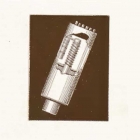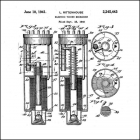Rittenhouse Rhythm Master Sequencer
The Rittenhouse Rhythm Master Sequencer is an electrical timing mechanism invented by Lloyd Rittenhouse in 1940.
When the doorbell button is engaged, a single solenoid is activated which lowers an eccentric contact attached to the solenoid armature. A spring compressed by the downward stroke of the armature, supplies the energy to return the armature upwards to the at rest position. The return is regulated by the flow of oil which must make it’s way around a metal ball that acts as a control valve. As the armature returns to the at rest position, it drags the arm across a series of contacts to momentarily close the three individual circuits sequentially which trigger solenoids which strike the tone bars to produce the melody.
Replacing the clumsy and complicated, dust-gathering mechanism found in ordinary chimes, this small steel cylinder (little larger than a man’s thumb) has only one moving part, which operated in oil, wholly enclosed and hermetically sealed. The Rhythm Master—an exlusive and patented Rittenhouse feature, assures faultless chime-striking sequence.
Rhythm Master mechanisms were employed in a number of Rittenhouse Door Chimes from the 1940s until the mid 1950s including the Beverly and the Sheffield.

